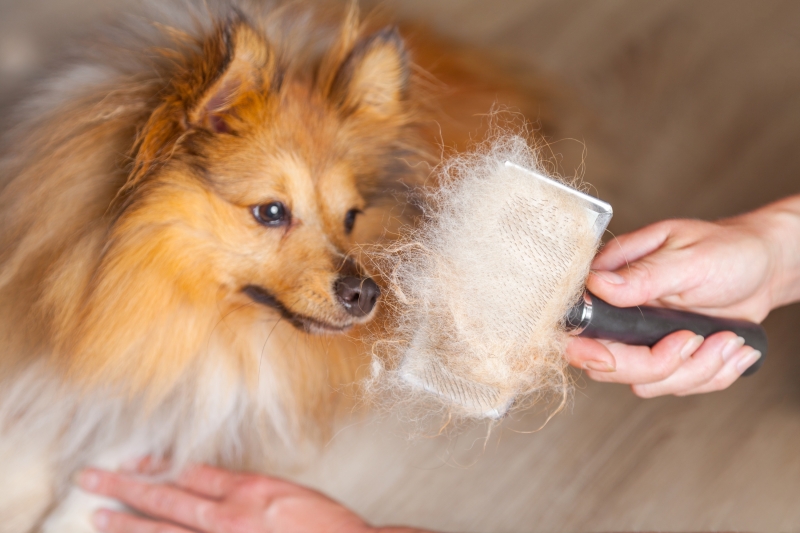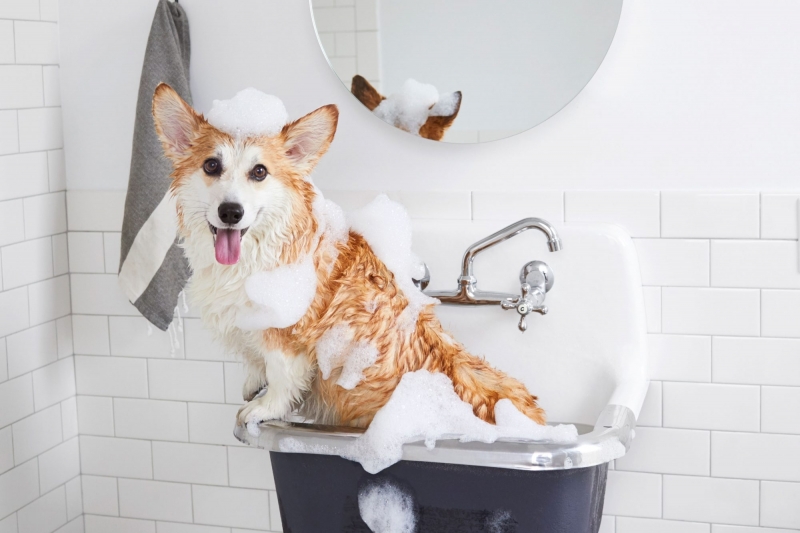The skin and coat of a dog not only reflect their health status but also evaluate their aesthetic appeal. Therefore, maintaining healthy skin and a shiny coat is something we should always prioritize. The methods of caring for the skin and coat vary depending on the breed of dog and factors such as bathing, brushing, and diet. Let’s explore how to take care of our furry companions’ appearance through the following article!
Ensuring that our dogs have healthy skin and glossy coats is essential for their overall well-being and appearance. Just like humans, dogs can suffer from various skin conditions, including dryness, itchiness, and infections. Regular grooming routines can help prevent these issues and keep their skin in top condition. Moreover, a shiny coat not only looks beautiful but also indicates good health in dogs.
When it comes to grooming, different breeds have different needs. For example, long-haired breeds like Golden Retrievers or Afghan Hounds require more frequent brushing to prevent matting and tangling of their fur. On the other hand, short-haired breeds such as Beagles or Dalmatians may need less frequent brushing but still benefit from regular grooming sessions to remove loose hair and distribute natural oils evenly throughout their coat.
Bathing is another crucial aspect of dog grooming. While it’s essential to keep your dog clean, bathing them too frequently can strip their skin of natural oils and lead to dryness and irritation. The frequency of baths depends on factors such as the dog’s breed, activity level, and environment. Generally, most dogs will only need a bath every few months unless they get exceptionally dirty or smelly.
Choosing the right shampoo is also important. Dog shampoos are formulated specifically for their skin pH and needs, unlike human shampoos which can be too harsh and drying for dogs. There are various types of dog shampoos available, including ones for sensitive skin, flea and tick control, and moisturizing. Selecting the appropriate shampoo for your dog’s specific needs will help maintain a healthy coat and skin.
In addition to grooming and bathing, diet plays a significant role in the health and appearance of a dog’s skin and coat. A balanced and nutritious diet rich in essential fatty acids, vitamins, and minerals is crucial for maintaining healthy skin and a shiny coat. Omega-3 and Omega-6 fatty acids are particularly important for skin health and can be found in sources such as fish oil, flaxseed oil, and certain types of fish like salmon.
Regular visits to the veterinarian are also essential for monitoring your dog’s skin and coat health. Your vet can provide valuable advice on grooming routines, recommend appropriate products, and diagnose any underlying health issues that may be affecting your dog’s skin and coat.
In conclusion, taking care of your dog’s skin and coat is not just about aesthetics; it’s a vital aspect of their overall health and well-being. By implementing a regular grooming routine, choosing the right products, and providing a balanced diet, you can help your furry friend maintain a healthy and beautiful appearance for years to come.
1. Brush your dog properly
The natural oils in a dog’s coat serve as a protective barrier, and regular brushing not only helps to ward off dirt and mats but also improves blood circulation, promoting overall skin health. Dogs often find the grooming process relaxing and enjoyable when done regularly. Dirty or matted fur not only causes discomfort but also increases the risk of various skin ailments, providing favorable conditions for harmful parasites to thrive.
Many dog breeds undergo heavy shedding during the spring and fall seasons. During these shedding periods, it’s essential to use thinning combs or brushes to remove the old, loose fur and facilitate the growth of new, healthy hair. When brushing your dog’s coat, pay special attention to areas prone to issues such as mats, shedding, or damaged skin.
Often, many pet owners focus solely on brushing the fur on the back and sides of their dogs. However, neglecting areas like the neck, throat, and between the legs can lead to mats and tangles. Dogs are typically sensitive around their belly and other delicate areas, and they may react defensively if these regions are touched or brushed. In such cases, they might nip at the brush or your hand.
It’s crucial to approach grooming with patience and gentleness, especially when dealing with sensitive areas. Gradually introducing your dog to grooming tools and techniques can help them feel more comfortable and cooperative during the process. Additionally, offering treats and praise as rewards for good behavior can further reinforce positive associations with grooming.
Regular grooming not only keeps your dog looking neat and tidy but also promotes their physical and emotional well-being. It strengthens the bond between you and your furry friend and allows you to monitor their skin and coat health closely. Remember, grooming is not just a chore; it’s an essential aspect of responsible pet ownership and contributes to your dog’s overall quality of life.

2. Bathe your dog regularly

Dogs require specific bathing products tailored to their fur type and skin condition. For dogs that spend a lot of time outdoors, using a protective shampoo against ticks and fleas is essential. When bathing your dog, it’s best to use lukewarm water to wet their entire body gently, then apply the shampoo evenly over their coat. Afterward, rinse thoroughly with clean water and towel dry before brushing their fur.
Choosing the right shampoo for your dog is crucial to ensure their skin and coat remain healthy. Different shampoos cater to various needs, such as moisturizing, deodorizing, or addressing specific skin conditions like itching or allergies. Consulting with your veterinarian can help you select the most suitable shampoo for your dog based on their individual requirements.
When bathing your dog, it’s essential to be cautious around sensitive areas such as the eyes, ears, and genital region. Use a mild shampoo specifically formulated for dogs, as human shampoos can be too harsh and may irritate their skin. Additionally, avoid getting water or shampoo into your dog’s ears to prevent infections.
After bathing, thoroughly rinse off all traces of shampoo to prevent residue buildup, which can lead to skin irritation or dryness. Use a clean, dry towel to gently pat your dog’s coat dry, taking care not to rub too vigorously, as this can cause tangling or matting of the fur. Finally, use a suitable brush or comb to remove any remaining tangles and promote even distribution of natural oils throughout the coat.
Regular grooming and bathing are essential for maintaining your dog’s overall health and hygiene. Not only does it keep their coat clean and free of dirt and parasites, but it also provides an opportunity to check for any signs of skin problems or injuries. By establishing a consistent grooming routine and using appropriate bathing products, you can help your dog look and feel their best while ensuring their well-being for years to come.
3. Reasonable diet
A balanced and nutritious diet is crucial for ensuring that a dog’s skin and coat remain shiny and healthy. The nutritional needs of dogs vary depending on factors such as age, breed, life stage, and activity level. Without an adequate intake of protein, fats, vitamins, Omega-3 and Omega-6 fatty acids, and essential minerals, their skin and coat may suffer, leading to issues such as dryness, excessive shedding, or skin irritation. Therefore, it’s essential to adjust their diet accordingly to address these health concerns.
For puppies, a diet rich in nutrients is vital for healthy growth and development. Look for specially formulated puppy food that provides the necessary balance of proteins, fats, vitamins, and minerals to support their rapid growth and development. As dogs age, their nutritional needs may change, so it’s essential to transition them to an adult formula tailored to their specific requirements.
Certain breeds may have unique dietary needs or be predisposed to certain health conditions that can affect their skin and coat. For example, breeds with long or dense coats may benefit from supplements containing Omega-3 fatty acids to promote skin health and reduce shedding. Additionally, dogs with allergies or sensitivities may require hypoallergenic diets to prevent skin reactions and maintain a healthy coat.
Regularly monitoring your dog’s skin and coat condition can provide valuable insights into their overall health and nutritional status. If you notice any changes such as dryness, dullness, excessive shedding, or skin irritation, it’s essential to consult with your veterinarian to rule out any underlying health issues and adjust their diet accordingly.
In conclusion, a well-balanced and tailored diet is essential for maintaining your dog’s skin and coat health. By providing them with the necessary nutrients and adjusting their diet as needed, you can help ensure that they have a shiny, healthy coat and radiant skin throughout their lives